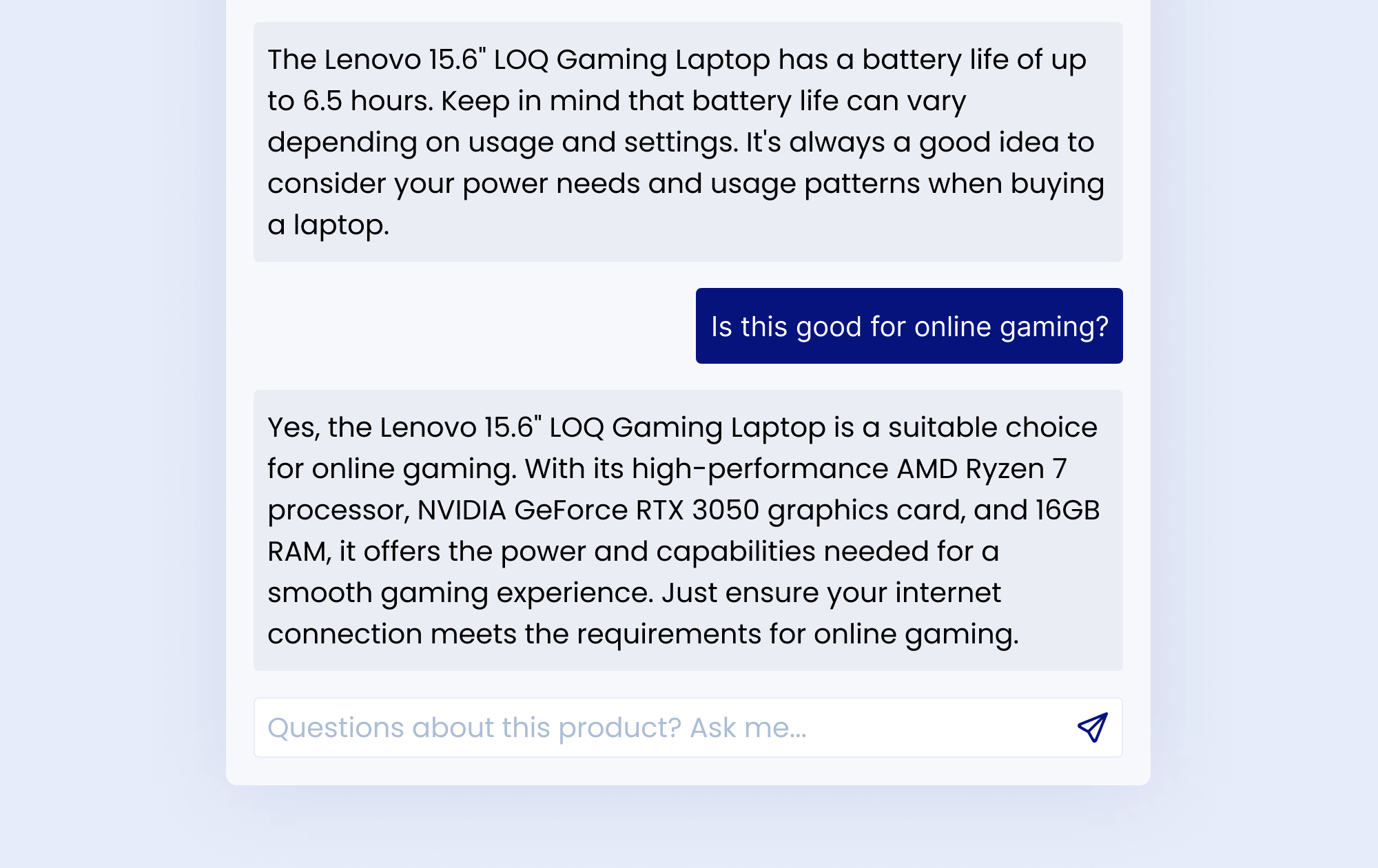How generative AI is solving a fundamental flaw in ecommerce
A lot of issues faced by ecommerce companies can be traced back to an original sin committed by the industry—it expected customers to do the work.
When buyers flocked online to find products, they were met with vague or overly technical descriptions. It was up to them to learn what separated one laptop from another or what RAM meant. It was a big change from the highly personal and interactive experience of shopping in store.
Fast forward 25 years and not much has changed. I recently went searching for a DSLR camera. I looked at 12 options and encountered terms like ‘24.2 megapixel DX-format CMOS sensor,’ ‘EXPEED 4 processor,’ and ‘low-light sensitivity to ISO 25600.’ All I wanted to know is if this camera would take great quality pictures for family events. But I had to do an hour of research just to narrow my choices and understand a handful of terms.
No wonder the average conversion rate in ecommerce is only 2.5% compared to 30% in-store.
How do you solve a problem so pervasive and embedded in ecommerce? That’s where generative AI comes in.
While AI has been used in ecommerce since day-one, generative AI is a newer concept. It’s free from the flaws and biases built into past iterations of AI. This is an era when ecommerce companies can build something better, from scratch. And because generative AI has the power to create, modify, optimize, and automate at scale, it’s a perfect candidate to atone for the original sin of ecommerce.
This article will examine this potential tipping point for ecommerce and all the ways generative AI can help the industry adapt to the needs, behaviors, and language of consumers.
See what over 1,000 consumers said about their buying habits in the 2024 Consumer Trust Meter Report
But first, what is generative AI and how does it work?
What is generative AI?
Generative AI is an algorithm that can create something. As the name suggests, it generates content and information. You can think of it as a digital artist, writer, and problem solver rolled into one.
Ask the algorithm a question and it will give you an answer. Tell it to write a song and it will. Request an image of a basketball game on the moon and it will draw it.
How does generative AI work?
Generative AI operates on two elements: Data and human interaction.
Every generative AI program is fueled by data. When given a task, the AI will scan whatever data set is made available to get an answer. That might be a relatively small amount of content on a specific website or billions of pieces of content from millions of websites. It learns about the information it finds and how it can be put together to provide a complete, correct, and coherent answer.
The program also requires human interaction. It relies on prompts to know what information to scan and what information to provide. For example, you could ask a generative AI program, “How many SKUs does the average ecommerce company sell?” The AI might use a mix of licensed data, data created by human trainers, and publicly available data to generate an answer. Generative AI algorithms also rely on humans to point out mistakes, inaccuracies, and unintelligible answers to learn and improve over time.
16 ways generative AI can be used in ecommerce
1. Personalized product recommendations
A lot of people know they need to buy something—they’re just not sure of the specifics. For example, they know they need a vacuum, but not much more. The process of researching, discovering, evaluating, and purchasing takes a lot of time in these situations. Generative AI can accelerate it all by allowing customers to ask for recommendations or answer questions about their needs, preferences, and lifestyle. The AI will take this information and provide highly personalized product recommendations.

2. Personalized product descriptions
Generative AI can take generic and overly technical product descriptions and customize them for each customer. Shoppers can understand why a product is perfect for them without deciphering tech-speak. For example, this allows a Gen Z gaming enthusiast and Baby Boomer consultant to understand how the same laptop fits their need for a portable computer with lots of storage space.

Read about nine ways to optimize your product detail pages to get more conversions
3. Product Q&A
Customers have questions about products. If they can’t find them on your website, they’ll go elsewhere or abandon their search. In fact, 36% of shoppers bail on their journey due to a lack of information or poor information, according to a recent survey by Reputation Leaders and Zoovu. Generative AI can answer customer questions about products by providing detailed, informative responses, improving customer satisfaction and reducing the need for manual customer support.

4. Improved search function
A salesperson knows what you mean when you ask for a budget guitar for beginners. They’re able to understand what a low-cost option means and which guitars are basic enough. Search tools don’t usually have this level of understanding. Generative AI can bridge this gap. Not only is it able to process natural language queries, but it can ask for more information so it can return more relevant results.
5. Bundling and upselling
Product recommendations are usually best guesses of what customers want. But generative AI can make better connections between products, pick up on signals from shoppers, and recommend items that are genuinely complimentary to the customer. For example, let’s say a customer is searching for a watch that’s good for a frequent traveler. Not only can a generative AI program recommend a watch, but it can also recommend a travel case.

6. Virtual fittings/trials
In the recent survey by Reputation Leaders and Zoovu, 29% of consumers say they struggle to find products because they can’t physically touch them. While generative AI can’t transport your customers to a store, it can do the next best thing—digitally showcase how a product would look on them or in their space. For example, if a customer was shopping for a winter jacket, it can create an image of the customer wearing that item. Or if a customer is looking for the perfect couch, gen AI can be used with visual product configurators to show them what the products would look like in their living room or kitchen.

7. Support Q&A
There are few things more frustrating or time-consuming than looking through article after article in a help center or flipping through a 200-page manual to find the answer to a question. Generative AI can become a custom support chat, scanning all this content in seconds and giving customers the information they need. Better support means happier customers and gen AI can offer this without straining a company’s resources.
8. SEO optimized product descriptions
Crafting hundreds or thousands of product descriptions for a search engine is like painting every room in an apartment complex—it’s a never-ending, monotonous task. By the time you finish the project, you have to start all over again because Google’s algorithm has changed or product descriptions are out of date. Generative AI transforms this manual task into an automated one. Provide it with a list of product descriptions and keywords, and it can generate thousands of pieces of SEO copy in minutes.
9. Write support and how-to articles
The number of ways a customer can use your products (and the problems they might face while doing them) will almost always outpace your ability to create content addressing these use cases. But with generative AI, good product data, and a few dozen articles to get you started, you can build a huge library to cater to diverse and niche customer questions for every product.
10. Write brand content
While generative AI isn’t good enough to write full pieces of content for your brand with the expertise of a human, it can help your team create content faster. There are a few ways it can do this, from giving your team ideas about what to write about to summarizing research and generating images, either to go with content or to provide inspiration for your design team.
11. Dynamic pricing
Generative AI gives ecommerce companies the ability to increase or decrease the price of thousands of products in real-time based on market factors, like historical sales data, customer behavior, inventory levels, competitor pricing, and market demand. For example, if demand for a product skyrockets or a competitor lowers their price for a similar product, you can raise or lower the cost accordingly.
12. Targeted emails and ads
It would take an entire team of copywriters to design emails and ads for the dozens or hundreds of specific shopper segments. And that’s not counting the time spent putting together those segments based on mountains of behavioral data. This is work that a generative AI system can do in a few minutes, spinning up ads and emails tailored to small groups of customers based on their needs, preferences, and lifestyle. While Jack will get an ad for a certain vacuum worded a certain way because he has children and a dog, and lives in a house, Jill will get an email, worded a different way, for a different vacuum because she’s single, lives in an apartment, and likes to bake.
13. Translation
Generative AI can translate entire sections of an ecommerce website into any language in less than a day. The translations aren’t 100% perfect, and they often don’t pick up regional nuances, such as tone and formality. However, having a native speaker review and make small tweaks is a lot less expensive and time-consuming than contracting a completely manual translation project.
14. Understanding analytics
Having lots of data is table stakes these days. Everyone has dozens of reports about ecommerce performance and customer behavior they can view and filter any way they want. But the data is often missing the ingredients that make it useful for creating and adjusting strategy—insight, understanding, and action. Generative AI can be the missing link in this equation, giving teams the ability to ask questions about their data and how to use it, then get a response from AI that is clear and actionable.
15. Sales and support enablement
The best sales and support people have seen it all and have built up the knowledge to tackle any questions, problem, or situation. Imagine fitting all this expertise into a tool that anyone can use in real-time. Fortunately, you don’t have to image with generative AI solution—it can help your sales and support staff find products, configure quotes, troubleshoot customer issues, and more.
16. Analyzing customer sentiment (reviews, feedback, etc.)
The best data on your customers comes directly from them—what they say on review sites, in emails, on phone calls, and other forums. That data is usually messy, unstructured, and hard to analyze for trends. Generative AI can dive into this deep pool of insights and find common sentiments and phrases. Discover how your customers perceive everything from your company’s products to its customer service, prices, shipping policies, and more.
Conclusion
For the explosion in generative AI talk and tech in the last couple of years, it’s worth remembering that it’s still a relatively new part of ecommerce. While the number of generative AI applications is rapidly expanding, the key to harnessing its true potential is to find your primary use cases and start there. And because gen AI is only as good as the data it uses, the first step to integrating it in any capacity is to ensure your data is in one place, clean, and enriched.


